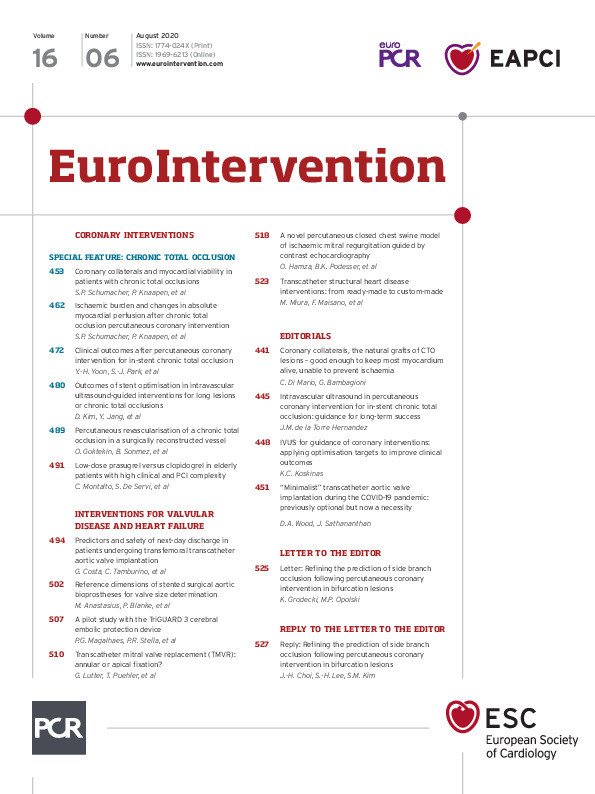
Transcatheter aortic valve implantation (TAVI) may become the predominant therapy for the majority of patients with calcific aortic stenosis, irrespective of surgical risk1,2. This reflects an expansion in indications over time since the initial cases were performed over 15 years ago. Similarly, implantation technique and preprocedural, periprocedural and post-procedure care have evolved with many centres adopting a “minimalist” approach for TAVI cases.
In this issue of EuroIntervention, Costa and colleagues demonstrate the safety and efficacy of next-day discharge in a large series of unselected patients at a single centre3.
After adjustment, there were no differences in all-cause mortality, permanent pacemaker implantation, or heart failure rehospitalisation at one year in the next-day discharge versus non-next-day discharge patients. This study adds to an established evidence base of two prospective multicentre trials in North America and Europe which have demonstrated the feasibility and safety of early discharge across different centres and geographies4,5. The 3M TAVI Study demonstrated that, in carefully selected patients, a much higher rate of next-day discharge (80.1%) can be achieved using a balloon-expandable transcatheter heart valve. Achieving a high rate of next-day discharge is not merely predicated on early discharge alone, but rather encompasses an entire clinical pathway. The key principles of a successful “minimalist” approach are achieving optimised preprocedural, periprocedural and post-procedural care for patients undergoing TAVI. While optimising patient outcomes and at the same time minimising infrastructure requirements was important prior to the COVID-19 pandemic, it is now crucial as Heart Teams make challenging decisions in the coming months.
The world is currently in the midst of a pandemic that has led to significant morbidity and mortality6,7. This has placed considerable strain on existing healthcare resources. As resources are redirected to address the COVID-19 pandemic, this has led to the restriction or cessation of many cardiovascular procedures and tests. Many centres have limited their TAVI procedures to performing only urgent cases or in highly symptomatic patients. It is important that Heart Teams are able to adapt rapidly as the pandemic escalates and abates. The Society of Cardiovascular Angiography and Interventions (SCAI) and the Canadian Association of Interventional Cardiology (CAIC) have both released position statements outlining recommendations for the provision of structural heart procedures during the COVID-19 pandemic8,9. The CAIC recommendations were designed to allow clinicians and policy makers to triage structural heart procedures as the pandemic evolves over the coming months.
In the short term, as many regions approach the initial peak of the pandemic, there may be limited anaesthetic support, intensive care facilities or hospital beds. The ability to perform TAVI in selected cases with minimal resources and yet achieve a high rate of same- or next-day discharge is desirable. It mitigates the risks of COVID-19 transmission to the patient in the hospital setting and enables continued provision of essential cardiovascular care to high-risk aortic stenosis patients at a time of significant resource constraint. In the long term, when the pandemic abates, structural programmes will probably face significant waiting lists and a high burden of patients with progressive symptomatic aortic stenosis. Lengthy delays may have significant detrimental effects even in patients who were initially considered to have a low risk of short-term cardiovascular events. A minimalist approach can aid in addressing these challenges. One option may be to increase procedures in a standard cardiac catheterisation laboratory, and to avoid critical care services, with all post-procedural care on a standard cardiovascular ward. This approach has been shown to be reproducible in many patients without any compromise to patient safety10.
Society faces an unprecedented challenge to overcome the COVID-19 pandemic. As cardiovascular physicians, we must ensure that essential TAVI services are provided for patients at high risk for cardiovascular events in the short term, while still acknowledging the need to focus the majority of healthcare resources on the pandemic. A minimalist approach to TAVI that ensures patient safety without utilising crucial critical care infrastructure may once have been desirable; however, it is now mandatory.
Conflict of interest statement
D.A. Wood has received grant support from Edwards Lifesciences and Abbott Vascular and is a consultant to Edwards Lifesciences, Medtronic and Abbott Vascular. J. Sathananthan is a consultant to Edwards Lifesciences and Medtronic.
Supplementary data
To read the full content of this article, please download the PDF.

